Guillaume Desnoues (born 1650 - died 1735) was a French surgeon. [1]
Guillaume Desnoues (born 1650 - died 1735) was a French surgeon. [1]
He studied with Lescot, in 1680 he was received at the Academy of New Discoveries of Medicine by Nicolas de Blégny, he was forced into exile and, around 1691, was a surgeon in Genoa where he succeeded Lescot. He was the first surgeon of the hospital and linked with Gaetano Zumbo for the presentation of anatomical waxes, after his estrangement with the latter, he collaborated with François De la Croix who was an ivory sculptor. [2]
Alfred Franklin notes in his Dictionary: "Desnoues having completed his work opened in the rue de Tournon, a museum made up of numerous wax pieces. One admired there above all a whole man, a girl about twelve years old, a woman nine month, "with the child still lying in the womb. Everything there is so just and natural that nothing is missing even in the smallest veins; the wax being sometimes red, sometimes white, blue, mixed, according to the various colors of the fleshy parts or veins of the human body [Nemeitz, Séjour de Paris , vol. I, p. 373]". Vigneul-Marville, who had seen all this, also praises it highly [ Mixtures of History and Literature, t. III, p. 307.]. The admission price, quite expensive for the time, was fifty cents." [1] [3]
In 1704 he went to Bologna, Florence in 1706 to Rome where he presented his anatomical preparations. He did the same in Paris in 1717, in 1719 in London and in 1720 passed through Amsterdam. [4]
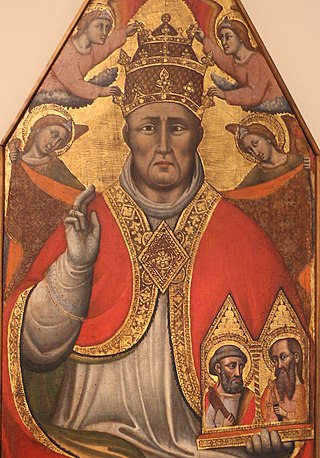
Pope Urban V, born Guillaume de Grimoard, was the head of the Catholic Church from 28 September 1362 until his death, in December 1370 and was also a member of the Order of Saint Benedict. He was the only Avignon pope to be beatified.
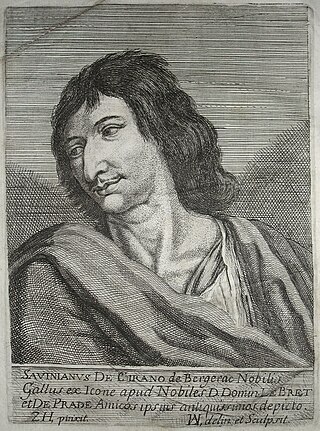
Savinien de Cyrano de Bergerac was a French novelist, playwright, epistolarian, and duelist.
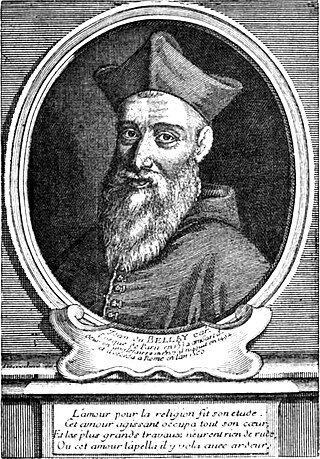
Jean du Bellay was a French diplomat and cardinal, a younger brother of Guillaume du Bellay, and cousin and patron of the poet Joachim du Bellay. He was bishop of Bayonne by 1526, member of the Conseil privé of King Francis I from 1530, and bishop of Paris from 1532. He became Bishop of Ostia and Dean of the College of Cardinals in 1555.

Pierre Belon (1517–1564) was a French traveller, naturalist, writer and diplomat. Like many others of the Renaissance period, he studied and wrote on a range of topics including ichthyology, ornithology, botany, comparative anatomy, architecture and Egyptology. He is sometimes known as Pierre Belon du Mans, or, in the Latin in which his works appeared, as Petrus Bellonius Cenomanus. The Russian physiologist Ivan Pavlov called him the "prophet of comparative anatomy".

Jean Carmet was a French actor.

Arnaud d'Ossat was a French diplomat and writer and a Cardinal of the Roman Catholic Church, whose personal tact and diplomatic skill steered the perilous course of French diplomacy with the papacy in the reign of Henry IV of France.
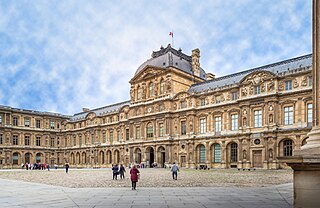
The Louvre Palace, often referred to simply as the Louvre, is an iconic French palace located on the Right Bank of the Seine in Paris, occupying a vast expanse of land between the Tuileries Gardens and the church of Saint-Germain l'Auxerrois. Originally a defensive castle, it has served numerous government-related functions in the past, including intermittently as a royal residence between the 14th and 18th centuries. It is now mostly used by the Louvre Museum, which first opened there in 1793.

Yvan Blot was a French conservative politician. A founding member of the GRECE, he was also the co-creator and president of the Club de l'Horloge.

Pierre Nicolas Gerdy was a French physician who was a native of Loches-sur-Ource.
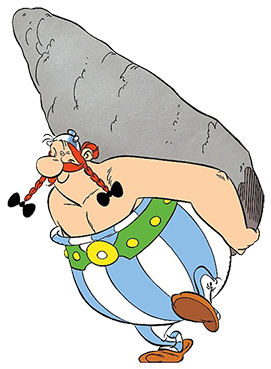
Jacques Morel was a French film and television actor. He was, perhaps, best known as the French language voice of the cartoon character, Obelix, in the animated adaptation of the comic book, Asterix.
The Musée d'Anatomie Delmas-Orfila-Rouvière was a museum of anatomy formerly located on the eighth floor of the Faculty of Medicine, Paris V René Descartes University, 45, rue des Saints-Pères, 6th arrondissement of Paris, France. It was the largest anatomy museum in France. It was closed around 2005, with all its exhibits going into storage.

Jean-Pierre Darroussin is a French actor and filmmaker. He was born in Courbevoie, France.
Nicolas-Félix Van Dievoet called Vandive, écuyer, (c.1710–1792) was a French court official

Joachim Charles Napoléon Murat, Prince of Pontecorvo, is a French aristocrat and member of the Bonaparte-Murat family.
Albert Rémy was a French actor best known for his supporting roles in François Truffaut's first two feature films. He played Antoine Doinel's father in The 400 Blows and Charlie Koller's brother in Shoot the Piano Player. He also appeared in Marcel Carné's Les Enfants du Paradis, John Frankenheimer's The Train and René Clément's Is Paris Burning?

Gaetano Giulio Zumbo (1656–1701) was an Italian sculptor in wax or wax modeller of the Baroque era. His primary talents were not those generally considered as artistic but devoted to the creation of scientific models that were highly regarded as curiosity pieces in his time. He has also been called an anatomist.
The grands corps de l'État are a feature of the French state as envisaged in the reforms of Jean-Baptiste Colbert. Some of these grands corps date back to the reign of Louis XV, in the 18th century, but most originated or were given their modern form during the reign of Napoleon.

Guillaume-Charles Faipoult was a French aristocrat, soldier and politician who was Minister of Finance during the French Revolution. He then represented France in Italy, where he organized the newly formed republics. During the First French Empire he was prefect of the Scheldt department, and then Minister of Finance in Spain under Joseph Bonaparte. Faipoult was prefect of Saône-et-Loire during the Hundred Days.
Yvan Chiffre was a French director, producer, and stunt coordinator. He is the father of Philippe Chiffre, Romain Chiffre and the grand father of César Chiffre.

The Pavillon du Roi was a tower-like structure built in the mid-16th century at the southern end of the Lescot Wing of the Louvre Palace. On its main floor was the primary apartment of the King of France. The pavilion served as a major emblem of the French monarchy for more than a century, and its design had seminal influence. From the 17th century, however, it gradually lost its visual and symbolic prominence. In the early 1640s, it was eclipsed by the slightly larger and more ornate Pavillon de l'Horloge; in the late 1660s, its main southern façade was hidden behind new structures; and in the early 19th century, its upper level was demolished and its interior arrangements were entirely remodeled.